Suzuki's SV650 was considered by many to be the king of the naked middleweights. For us at Motorcyclist, the SV was certainly the king of our motoring hearts in its heyday. First introduced in 1999, this Japanese twist on a Ducati Monster quickly became a sweetheart for beginners and intermediate riders alike thanks to its low price, great handling, and feisty V-twin engine. Even to this day the SV650 is a relevant roadracing option, in part because the surge of popularity created SV-based classes around the country that are still alive.
But not all first loves last forever, and our hearts were broken when Suzuki "updated" the loveable SV in 2008, restyling it and rebadging it as the Gladius, later renamed the SFV650. The bike was heavier, more expensive, and widely perceived as uglier than the bike it replaced, leaving fans of the original SV650 betrayed and mourning the loss of the wonderfully flexible bike. The king of the naked middleweight throne was banished to midsize mediocrity, and the hole left in the market was discernable.
Then, in 2015, an heir apparent! Yamaha released the spunky, lightweight FZ-07—a 400-pound parallel twin that punched way above its seven-grand price tag in terms of power, handling, and style. Seemingly in response to the FZ's arrival Suzuki reintroduced the SV650 as a significantly redesigned 2017 model, complete with a reduced price, more appealing looks, and a lower curb weight. In a lot of ways the FZ filled the void left by the SV's departure, but was it better than this new Suzuki? We couldn't say which of the two we preferred until we rode them back to back. On one hand, the SV650 has been resurrected with its same round headlight, second gen-esque tank, and the familiar V-twin thrum. On the other hand, the FZ-07 weighs less and has a surprisingly rowdy parallel-twin engine. Aside from those key differences the SV and the FZ are pretty comparable, so we dug a little deeper.
The Benchmark, Reborn At first glance, the 2017 SV650 reminds us of the pre-Gladius SV, and that resemblance is intentional. The tank shape evokes some of the angles of the previous bike and is far less globular than what was on the Gladius. The round headlight also gives a nod to the last critically acclaimed SV, showing us that familiar face again. The two color options for this year's SV are white or blue. What first appeared as a simple metallic white paint job on our test bike pleasantly surprised us with a blue pearlescent finish. This is most noticeable under the hot spot of an overhead light. Subtle but sexy!
The angular aluminum frame of the old SV650 is long gone—the 2017 machine uses the same steel-tube skeleton as the Gladius, which has ever-so-slightly more aggressive steering geometry than the previous bike. The repurposed frame looks better paired with the SV’s familiar tank shape and round headlight, making a very strong reference to the original SV650. Thankfully the old Gladius frame shrouds are minimized on the new SV, as the bare tubular-steel trellis frame speaks to the beloved simplicity of the original machine.
Firing up the SV650, which now comes with a one-touch “Easy Start” feature (wherein you dab the starter button and the ECU cranks the starter until the engine fires) as on the GSX-S1000, brings to life that familiar V-twin growl. It’s a bit raspier than before, kind of like hearing the voice of a long-lost friend, only after they’ve been smoking for 20 years. The SV also now has a Low-RPM Assist feature that dials up the revs a bit as you let out the clutch. It’s supposed to help keep newbies from stalling, but the Suzuki’s 645cc V-twin is so torquey off the bottom that stalling isn’t really a concern. Interestingly the clutch-lever pull is a bit heavy, for this segment anyway.
Once rolling, the SV dishes out plenty of usable power, and throttle response is nicely refined at higher revs but can feel a little abrupt when first getting on the gas at lower engine speeds. The engine feels relaxed and strong and purrs along smoothly at highway speeds with a nice loping sensation in the footpegs and tank sides. When we headed into the twisties, the V-twin’s torque meant we could carve in and out of the corners in one gear with plenty of roll-on power.
The Suzuki’s suspension is on the soft side, but it still has that harshness over hard-edged bumps and springs back quickly—a classic case of not enough rebound damping in the shock. Overall the Suzuki feels like it’s built for a rider who’s about 50 pounds heavier than the FZ rider. That being said, the bike feels so balanced and neutral that it’s not even necessary to lean off. It falls into corners easily, changes direction with very little effort, and communicates everything to the rider. The SV is a lot of fun on a twisty road.
It’s a well-engineered machine, and whether you like it or not, 431 pounds is pretty light these days. How does it stack up to the SVs of yore? When the SV came out in 1999 we filled it to the brim and weighed it at 413 pounds, so it’s gained 17 pounds in 17 years—such symmetry! What’s most impressive about the new bike is that the SFV it replaces was measured at 449 pounds with a full tank. Props to Suzuki for shedding the weight (and bonus points to Yamaha for the FZ being 400 pounds on the nose).
Bringing the Suzuki’s svelte new self to a stop are the same two-piston Tokico calipers that have hung from the bike’s fork tubes since 1999. Initial bite is not earth shattering, and there isn’t much feel, but ultimately they get the job done and have more power than the FZ’s binders. ABS will be offered as a $500 option later in the year, but our testbike was an early-release non-ABS model.
Another thumbs-up for the SV’s new digital gauge, mounted on the headlight side of the handlebar. This positioning keeps the gauge within your peripheral vision so you can simply glance down to monitor the bike’s vitals instead of moving your whole head to look for information. Overall the SV feels a little bigger than the FZ, with a reach to the handlebars that seems a couple of inches longer. And speaking of the Yamaha, there’s nothing like rehashing the virtues and failings of this long-lost love of ours to make us want to see how it stacks up against its spiritual successor.
The Feisty Featherweight The FZ-07 came to us in 2015 and has been a fun, spunky little ride, quickly becoming a favorite in the middleweight realm, especially given the absence of the SV. Aesthetically, it's a departure from the round headlight some might find boring on the SV. The FZ-07 is a clear younger sibling to the FZ-09: angular but with softened edges. Multiple layers of color and partial fairings create interest in the tank and airbox area. Compared to the new SV650 the FZ-07 is quite busy visually, but it does look like the FZ-09 and that's the idea.
Powering the midsize Yamaha is a softer-sounding 689cc parallel twin. Where the SV’s note is more gravelly and raspy, the FZ is more reminiscent of a sewing machine. It’s certainly less aggressive and, depending on your preference, more pleasant. If nothing else, the FZ’s understated exhaust and swooping headers are more tastefully executed than the SV650’s big ugly can and awkward plumbing. On the other hand, the Yamaha’s polite pipe makes way for a more aggressive personality when the throttle is twisted. The FZ’s rowdy nature reveals itself with immediate throttle response and a stronger, faster-revving engine. Yamaha’s parallel twin makes less peak horsepower (67.2 versus the SV’s 69.3 hp) but cranks out more torque (46.4 pound-feet compared to 44.2 pound-feet for the SV) and pours it on thicker in the low end of the rev range.
Part of that peppy feel certainly comes from the FZ’s lower weight: just 400 pounds with a full tank. Around town the Yamaha’s quick acceleration makes it a lot of fun to ride, but out on the freeway the parallel twin feels strained and buzzy. It’s not actually revving any higher than the SV, but it’s not as smooth. Appropriately suited to the FZ’s market, the clutch lever has a light feel and easy engagement, especially compared to the heavier clutch of the Suzuki.
Overall the Yamaha feels about 10 percent smaller than the Suzuki. Maybe because it’s designed for smaller riders, the suspension is noticeably softer. Although the fork and shock soak up bumps more readily in town, the bike wallows a bit more in fast twisties. The Yamaha’s chassis is stable like the SV, but the little FZ is noticeably more flickable. The center of gravity is low and the bike changes direction with almost no input.
We don’t care much for the SV’s old-school brakes, but they are better than the FZ’s setup. The Yamaha brakes, despite using more modern hardware, feel soft—there’s good initial bite but much less power than we would like. Also, you can’t get the FZ-07 with ABS—at least not yet.
While the FZ-07 is physically only somewhat smaller than the SV, the difference is noticeable. From the saddle the Yamaha feels significantly more compact and narrow. Given that the FZ-07 was designed with women, new riders, and short riders in mind, the bike’s stature makes sense, and we love that you can get such a good motorcycle in 7/8th scale. The reach to the handlebars is shorter on the Yamaha, and the digital gauge is mounted on the tank side of the handlebar. This placement keeps the gauge out of your peripheral vision, which means glancing down to look at the bike’s information. The seat feels softer and narrower, which should be appealing to riders of lighter weight and shorter inseam. While the FZ’s seat is actually almost a full inch taller than the SV’s, the bike’s lighter weight keeps it feeling lithe and nimble. Aside from being about 30 pounds lighter, the FZ seems to carry its weight lower, making that 30-pound difference feel more like 50.
ZACK COURTS SENIOR EDITOR AGE: 32 HEIGHT: 6'2" WEIGHT: 185 lb. INSEAM: 34 in. If you think we're going to have a hard time picking a winner here, you'd be right. Sorry, but the margins are really, really fine here. These are two bikes on top of their class, and the differences are extremely subtle. Except the brakes: How is it that those 20-year-old slide-pin binders on the Suzuki are that much better than the Yamaha's?
Even I, the ever-opinionated journalist, have a hard time picking one. I love the SV650: I love the round headlight, I prefer the slightly stiffer suspension, it fits my body type better, and I bet if it were mine I could retrofit it with some exhaust plumbing that didn’t look like a middle-school shop project. And I much prefer the sound of a V-twin. But that FZ-07! It’s just so rowdy! Only $7,000 for third-gear wheelies? Seriously?!What’s today, Thursday? I’d get an SV650. Ask me tomorrow and it might be different.
ARI HENNING SENIOR ROAD TEST EDITOR AGE: 31 HEIGHT: 5'10" WEIGHT: 175 lb. INSEAM: 33 in. I've owned two SVs and was part of the angry mob that felt Suzuki screwed up with the Gladius. In the SV's absence the FZ-07 won me over—every time I've ridden one I come away thoroughly impressed with the engine's power and character and I'm amazed that you can get a bike this good for so little. Yamaha could sell it for $8,000 and it would still be a killer deal!
Considering how great the FZ-07 is I figured that when I got the chance to ride the SV and the FZ together the Suzuki would be behind the times. As it turns out, it’s still a totally excellent bike. In fact, I prefer the Suzuki’s more refined engine, firmer suspension, and the extra space that its larger size provides. When we wrapped up this comparison I stayed on the SV650 for another two weeks while my long-term Aprilia Tuono 1100 sat in the garage. Maybe it’s just nostalgia, but I’m really, really happy that the SV is back.
IN THE END… This is the part where we tell you, hands down, that one bike is better than the other. Sorry, no can do. Both of these bikes are a thousand smiles in a bottle. The FZ-07 came along at a good time, when the market was salivating for a fresh take on what was a stale SFV platform. It hit home with new riders and veterans alike, and maybe our favorite part: It spurred Suzuki into action. As for the SV650, it has been faithfully revived. It is the wonderful all-arounder we all grew to love years ago, with a few updates to certain elements like the starter and optional ABS. It's heavier than the FZ, yes, and a little calmer, but then again that makes the Suzuki an excellent bike to grow into.
So the question is, do you want a smaller, lighter, softer, yet feistier bike to toss around town and the twisties? Then go for the FZ-07. Do you want something a bit more substantial, more refined, with a bit more classic-standard styling and a V-twin engine? Get an SV650. Truth is, there’s no wrong answer. Both are kings of the segment in their own way. Let’s just hope they can learn to share the throne.











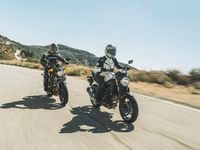
/cloudfront-us-east-1.images.arcpublishing.com/octane/AHTY4UROMUNXZXOZCFZGBGQZQI.jpg)
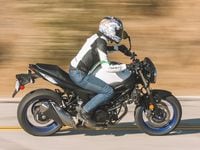
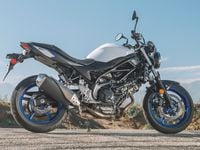
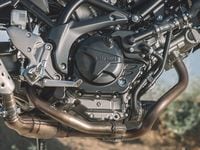
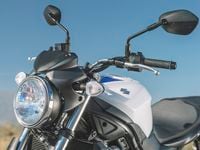
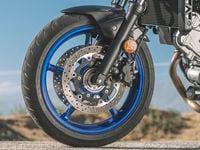
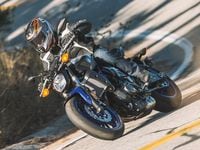
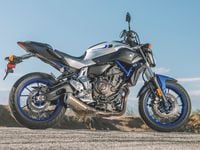
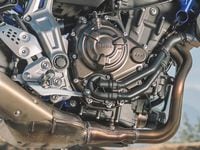
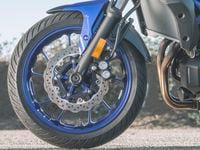





/cloudfront-us-east-1.images.arcpublishing.com/octane/MUQLOVLL2ZDGFH25ILABNBXKTI.jpg)
/cloudfront-us-east-1.images.arcpublishing.com/octane/TNOU5DNE2BC57MFPMGN2EIDXAM.jpg)
/cloudfront-us-east-1.images.arcpublishing.com/octane/GTCXACQGJ5HAPDTGWUQKDEH44E.jpg)
/cloudfront-us-east-1.images.arcpublishing.com/octane/S35YGSEMEZB4BLTDJTSZPF4GLA.jpg)
/cloudfront-us-east-1.images.arcpublishing.com/octane/5UOT6HPX2JFMRJAX6EH45AR4MQ.jpg)
/cloudfront-us-east-1.images.arcpublishing.com/octane/OKWOJWAKP5EP3OACCRRWPCIX2Q.jpg)
/cloudfront-us-east-1.images.arcpublishing.com/octane/2WF3SCE3NFBQXLDNJM7KMXA45E.jpg)
/cloudfront-us-east-1.images.arcpublishing.com/octane/G4MG6OUCJNBSHIS2MVVOTPX65E.jpg)
/cloudfront-us-east-1.images.arcpublishing.com/octane/IIGGWFOTOJGB7DB6DGBXCCMTDY.jpg)
/cloudfront-us-east-1.images.arcpublishing.com/octane/QSTCM6AVEZA5JJBUXNIQ3DSOF4.jpg)
/cloudfront-us-east-1.images.arcpublishing.com/octane/U4I7G625B5DMLF2DVIJDFZVV6M.jpg)
/cloudfront-us-east-1.images.arcpublishing.com/octane/B6XD6LS6IVCQPIU6HXDJSM3FHY.jpg)
/cloudfront-us-east-1.images.arcpublishing.com/octane/ICL63FEDDRDTTMINYICCEYGMDA.jpg)
/cloudfront-us-east-1.images.arcpublishing.com/octane/FCGZHQXRBZFLBAPC5SDIQLVF4I.jpg)
/cloudfront-us-east-1.images.arcpublishing.com/octane/WNOB6LDOIFFHJKPSVIWDYUGOPM.jpg)

/cloudfront-us-east-1.images.arcpublishing.com/octane/X33NU3E525ECRHXLNUJN2FTRKI.jpg)
/cloudfront-us-east-1.images.arcpublishing.com/octane/6KKT5NNL2JAVBOXMZYS5ZO76YA.jpg)
/cloudfront-us-east-1.images.arcpublishing.com/octane/J5RKG5O455GMPGQRF2OG6LRT7A.jpg)
/cloudfront-us-east-1.images.arcpublishing.com/octane/GX2CIZKQVRH2TATDM26KFG2DAE.jpg)
/cloudfront-us-east-1.images.arcpublishing.com/octane/ZWIDYSAKQZHD5BHREMQILXJCGM.jpg)
/cloudfront-us-east-1.images.arcpublishing.com/octane/CYUHJZCTSJCH3MRAQEIKXK7SCQ.jpg)
/cloudfront-us-east-1.images.arcpublishing.com/octane/LKOFINY56FCXJCANJ5M7ZDQUBY.jpg)
/cloudfront-us-east-1.images.arcpublishing.com/octane/4NBPDACMWJH63JQYJVK3QRBDZI.jpg)